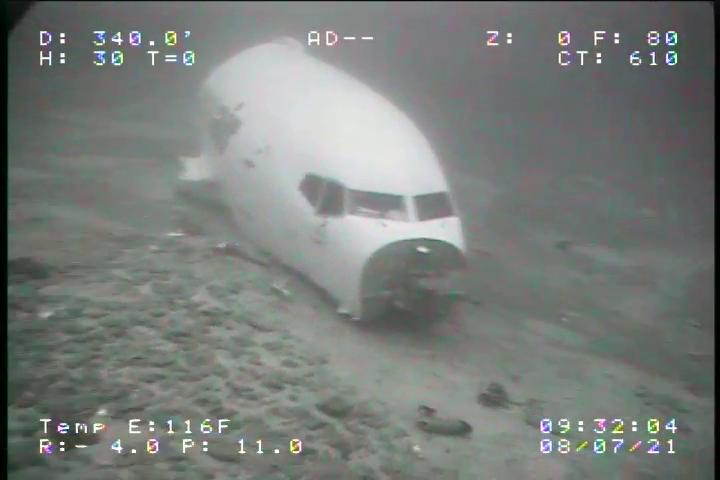On July 2, 2021, cargo Transair Flight 810 (Part 121) departed Honolulu International Airport (PHNL) at 0130 HST. Shortly after take-off (at approximately 390 ft AGL), the Boeing 737-200 experience partial power loss of the right engine and underwent a forced ditching 11.5 minutes after departure, approximately 5.5 miles southwest of Honolulu. The only two crewmembers aboard were rescued and sustained 1 serious injury (Captain) and 1 minor (First Officer) injury; both were released from the hospital within 2 days of the accident.
Both pilots initially identified that the right engine “had lost power”. Rightward yaw was corrected with 5.5 deg of left rudder. Subsequently, the Captain cleaned up the remaining flaps and reduced the power levers to maximum continuous thrust. Upon reaching 2100 ft MSL, the Engine Pressure Ratio (EPR-indicator of thrust being produced by the engine) of the Left (Number one) engine gradually started decreasing to near flight idle over 1 min and 17 seconds. Four minutes after take-off, while working the problem, the Captain stated:
“let’s see what is the problem...which one...what’s going on with the gauges,” and “who has the E-G-T?” The first officer stated, “it looks like the number one [engine].”About that time, the EPR on the left and right engines was 1.05 and 1.12, respectively. At 0137:54, the captain asked, “number one is gone?” The first officer replied that the left engine was “gone” and that “we have number two”; at 0137:58, the captain repeated “we have number two” and stated “okay.” Between 0137:59 and 0138:10, the right EPR level (which had been slowly increasing after reaching a level of 1.09) increased quickly from 1.12 to 1.18.” (Copied from NTSB report).
(Note by author: An EPR of 1.0 is approximating flight idle and 2.0, full power; Left engine is referred to as “Number One” and Right engine referred to as “Number Two”.)
From that point forward, the flight crew was laboring under the belief that the Left engine had failed (producing zero thrust) and the Right engine was the operating engine. As time progressed, the “health” of the right engine was called into question with the crew believing they were dealing with a potential dual engine failure, since the Right engine was progressively going over design temperatures and producing reduced thrust. All the while, the Left (Number One engine) thrust lever was set at “flight idle”. The aircraft lost altitude and airspeed, and ditched approximately 12 minutes after take-off. The aircraft was subsequently recovered upright in 350 ft of water. It was noted to be in two major pieces-with the fuselage forward of the wing roots separating from the rest of the aircraft.
Post-crash analysis revealed that the left engine was essentially normal and the right engine had evidence of fractured high pressure turbine blades. Metallurgical examination of the blades revealed loss of strength due to oxidation and corrosion, at lightening (weight reducing) holes. There were also changes to some high-pressure blades suggestive of operating temperatures beyond normal operating limits. In addition, testing by The Boeing Aircraft Company demonstrated that the aircraft, under similar environmental and loading conditions, would be capable of sustained flight on one operative engine.
What the NTSB Found
“We determined the probable cause(s) of this accident to be: The flight crewmembers’ misidentification of the damaged engine (after leveling off the airplane and reducing thrust) and their use of only the damaged engine for thrust during the remainder of the flight, resulting in an unintentional descent and forced ditching in the Pacific Ocean. Contributing to the accident were the flight crew’s ineffective crew resource management, high workload, and stress.”
(NTSB Aviation Final Report: DCA21FA174)
The detailed NTSB Final Report evokes feelings of a B-Rated Horror movie. Throughout the “manuscript” one shouts: “Try the left engine! Please, TRY the LEFT engine!” as the aircraft slowly drifts toward the dark Hawaiian waters. Alas, our “heroes” run out of time and end up in the proverbial “drink”. The great news is that both pilots survived the ordeal (unusual for most B-Rated Horror Flicks!)
There is much to digest in this accident and subsequent analysis. The NTSB was critical of crew coordination in dealing with the emergency (roles switched back and forth between the Captain and First Officer (FO) regarding partial (incomplete) emergency checklist use, role of Captain vs FO regarding communication and troubleshooting, command (Captain) authority and delegation of resources, and of course, fixation errors. (author’s note).
To me, however, the real lesson for all aviators, is how insidious stress and confirmation bias (i.e.-convincing yourself what you think is true, really is true, despite evidence to contrary) led these experienced aviators astray, producing a horrendous fixation error. The Captain had 15,781 (total time) and 871 hours (in make and model); the First Officer had 5272 and 908 hours, respectively. And yet, somehow, under the stress of the moment, they had absolutely convinced themselves that the Number One (Left ) engine was “gone”, despite having previously correctly identifying the Number Two (Right) engine as having been the culprit.
Rather than being critical of their collective performance, we should instead acknowledge how extremely powerful our confirmation biases can be when under extreme pressure and extreme time constraints.
Perhaps studying this accident will stimulate some aviator, when under similar in-flight emergency pressure, to “dig” into the recesses of their “primordial brain” and ask the question, “What is really going on here?”
Take a step back and try to look at the problem from a fresh perspective.
Fly Like Your Life Depends on It!
Joe Romson, CFI
Director of Safety
JATO Aviation, LLC
References:
1. Blancolirio Channel
2. NTSB Aviation Final Report: DCA21FA174

